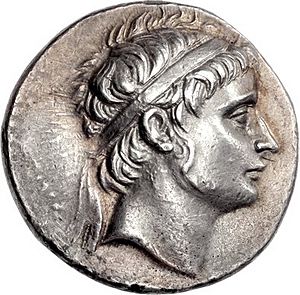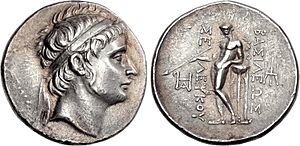Seleucus II Callinicus facts for kids
Quick facts for kids Seleucus II Callinicus Pogon |
|
|---|---|
| Basileus | |

Silver tetradrachm of Seleukos II Kallinikos, minted in Antioch, featuring a portrait of Seleukos on the obverse. SC 689.6b
|
|
| Basileus of the Seleucid Empire | |
| Reign | July/August 246 – December 225 BC |
| Predecessor | Antiochus II Theos |
| Successor | Seleucus III Ceraunus |
| Born | c. 265 BC |
| Died | December 225 BC (aged 39–40) |
| Spouse | Laodice II |
| Issue |
|
| Dynasty | Seleucid |
| Father | Antiochus II |
| Mother | Laodice |
Seleucus II Callinicus Pogon was a king of the Seleucid Empire, a large kingdom that was part of the Hellenistic world. He ruled from 246 BC to 225 BC. His full name, Seleucus II Callinicus Pogon, means "beautifully triumphant" (Kallinikos) and "the Beard" (Pogon). His time as king was very difficult. He faced many enemies and his empire started to break apart. Later, his second son, Antiochus III the Great, helped bring the empire back together.
Contents
Becoming King and Early Challenges
After his father, Antiochus II Theos, died in 246 BC, Seleucus was made king by his mother, Laodice I. This happened in a city called Ephesos. But his father's other wife, Queen Berenice, also said her son Antiochus should be king in Antioch.
Berenice quickly took control of most of Syria and Cilicia. However, before her brother, Ptolemy III of Egypt, could arrive to help her son, Berenice was killed. This was done by people who supported Seleucus II and Queen Laodice.
The Third Syrian War
This family fight started a big conflict called the Third Syrian War. Ptolemy III, the king of Egypt, invaded the Seleucid Empire. He landed at Seleucia Pieria and took control of Syria and Cilicia. He marched far into the empire.
Ptolemy stayed in Syria during the winter of 246-245 BC. Seleucus tried to send ships to get the area back, but a storm destroyed them. He had a lot of bad luck during his reign.
Battles and Peace in the West
Seleucus managed to keep control of some areas in Asia Minor. He made alliances by marrying his sisters to other rulers. One sister married Mithridates II of Pontus, and another married Ariarathes III of Cappadocia. Seleucus himself married his aunt, Laodice II. They had five children, including Antiochis, Seleucus III Ceraunus, and Antiochus III the Great.
Seleucus then made his brother, Antiochus Hierax, a governor in Asia Minor. After that, Seleucus marched to fight the Ptolemies.
Regaining Lost Lands
Ptolemy III went back to Egypt in 245 BC. He reportedly took a lot of gold and statues of Egyptian gods that had been stolen centuries before. Seleucus went to Babylonia and Mesopotamia first, where people welcomed him. Then he marched into Syria and took back Antioch by 244 BC. He also recaptured other important cities. By 242 BC, he had regained northern Syria. He even attacked areas in Syria that Ptolemy controlled, near Damascus.
However, the Seleucids were not successful everywhere. In the Aegean Sea, Ptolemy's armies took control of Ephesos and other cities.
The Peace Treaty
In 241 BC, Seleucus and Ptolemy finally agreed to peace. Ptolemy recognized Seleucus as king. The Eleutheros river became the border between their empires in Syria again. But Ptolemy kept his gains in Thrace, Ephesos, and the important port of Seleucia Pieria. This city was very important because it had the tomb of the Seleucid dynasty's founder, Seleucus I. It also controlled much of the trade from Antioch. The Seleucids really wanted to get this city back, which later caused another war.
Conflict with his Brother
Meanwhile, Antiochus Hierax, Seleucus's brother, started to act like a rival king in Asia Minor. Their mother, Laodice, supported him. Seleucus attacked Antiochus Hierax but could not take the city of Sardis. After two years, the brothers fought at the Battle of Ancyra around 237 BC. Antiochus Hierax won with help from Mithridates II of Pontus and the Galatians. Seleucus barely escaped with his life. After this, Seleucus left the land beyond the Taurus Mountains to his brother. An uneasy peace followed between them.

Problems in the East
Seleucus then focused on problems in the eastern parts of his empire. He tried to regain Parthia, but his efforts did not succeed.
The governor of Parthia, Andragoras, had become independent around 245 BC. But before Seleucus could deal with him, Andragoras was killed by Arsaces I of Parthia in 238 BC. Arsaces was a leader of the nomadic Parni people.
Another governor, Diodotus I, had also become independent in Bactria. He had used the Seleucid's problems in the west to his advantage.
After Seleucus's defeat at Ancyra, the Seleucid armies in the east became weaker. This allowed the Parthians under Arsaces to take more land, including the city of Hekatompylos. This city became their new capital around 237 BC. Around this time, Diodotus I was replaced by his son, Diodotus II. Diodotus II made an alliance with Parthia. This alliance created a barrier that made it hard for Seleucus to invade and take back the East.
Seleucus tried to recover Parthia, but he was defeated or had to retreat. The Seleucid Empire would only regain its strength in the East later, under his son Antiochus III. After this defeat, Diodotus II declared himself king of Bactria in 235 BC, officially breaking away from the Seleucid court.
Later Years and Death
Meanwhile, in Asia Minor, a kingdom called Pergamon became very powerful under King Attalus I. Attalus wanted to replace Antiochus Hierax as the main ruler in Asia Minor. This led to a big war in the 230s BC. Attalus defeated the Galatians, then Antiochus Hierax, and finally even Seleucus II himself. After losing four battles to Attalus, Antiochus Hierax ran away to Armenia. He then tried to invade Mesopotamia but was defeated again. Antiochus finally died in Thrace around 226 BC, killed by robbers.
Seleucus also had to deal with a rebellion in Antioch. This was started by his aunt, Queen Stratonice of Macedon. She had been married to King Demetrius II Aetolicus of Macedon. When Demetrius II took another wife, Stratonice returned to Syria. She wanted to marry Seleucus or have him attack Demetrius. Seleucus refused her ideas. Angry, she started a rebellion in Antioch. Seleucus had to surround the city to take it back. Stratonice tried to escape to Seleucia, hoping to find safety with Ptolemy III, but she was caught and executed.
After his defeat at Ancyra in 237 BC, Seleucus focused on rebuilding his kingdom. He made Antioch bigger and stopped rebellions in Babylon. By 227 BC, things were stable enough for him to plan a new attack against Attalus to regain Asia Minor.
The King's End
Before he could start this invasion, Seleucus died unexpectedly in 225 BC. He fell from his horse. His eldest son, Alexander, became king first, taking the name Seleucus III Ceraunus. Later, his younger son, Antiochus III the Great, became king in 222 BC.
See also
 In Spanish: Seleuco II Calinico para niños
In Spanish: Seleuco II Calinico para niños

